
Anemonoides nemorosa, the wood anemone, is an early-spring flowering plant in the buttercup family Ranunculaceae, native to Europe. Other common names include windflower, European thimbleweed, and smell fox, an allusion to the musky smell of the leaves. It is a perennial herbaceous plant growing 5–15 cm (2–6 in) tall.

Oxalis is a large genus of flowering plants in the wood-sorrel family Oxalidaceae, comprising over 550 species. The genus occurs throughout most of the world, except for the polar areas; species diversity is particularly rich in tropical Brazil, Mexico, and South Africa.
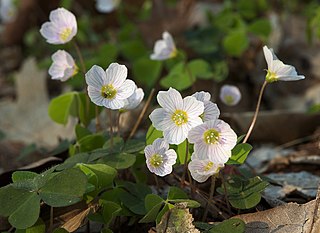
Oxalis acetosella, the wood sorrel or common wood sorrel, is a rhizomatous flowering plant in the family Oxalidaceae, common in most of Europe and parts of Asia. The specific epithet acetosella refers to its sour taste. The common name wood sorrel is often used for other plants in the genus Oxalis. In much of its range it is the only member of its genus and hence simply known as "the" wood sorrel. While common wood sorrel may be used to differentiate it from most other species of Oxalis, in North America, Oxalis montana is also called common wood sorrel. It is also known as Alleluia because it blossoms between Easter and Pentecost, when the Psalms which end with Hallelujah are sung.
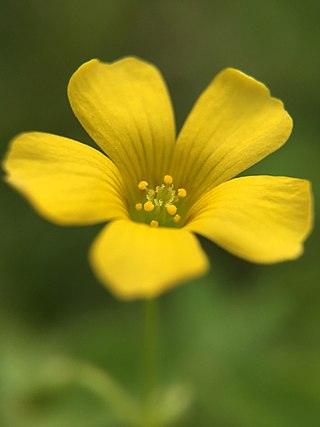
Oxalis corniculata, the creeping woodsorrel, procumbent yellow sorrel or sleeping beauty, is a somewhat delicate-appearing, low-growing herbaceous plant in the family Oxalidaceae.

The water-plantains (Alismataceae) are a family of flowering plants, comprising 20 genera and 119 species. The family has a cosmopolitan distribution, with the greatest number of species in temperate regions of the Northern Hemisphere. Most of the species are herbaceous aquatic plants growing in marshes and ponds.
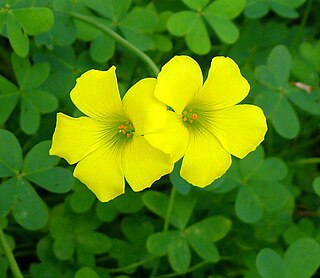
Oxalis pes-caprae is a species of tristylous yellow-flowering plant in the wood sorrel family Oxalidaceae. Oxalis cernua is a less common synonym for this species. Some of the most common names for the plant reference its sour taste owing to oxalic acid present in its tissues. Indigenous to South Africa, the plant has become a pest plant in different parts of the world that is difficult to eradicate because of how it propagates through underground bulbs.

Oxalis stricta, called the common yellow woodsorrel, common yellow oxalis, upright yellow-sorrel, lemon clover, or more ambiguously and informally "sourgrass", "sheep weed", or "pickle plant", is a herbaceous plant native to North America, parts of Eurasia, and a rare introduction in Britain. It tends to grow in woodlands, meadows, and in disturbed areas as both a perennial and annual. Erect when young, this plant later becomes decumbent as it lies down, and branches regularly. It is not to be confused with similar plants in the same genus which are also often referred to as "yellow woodsorrel".
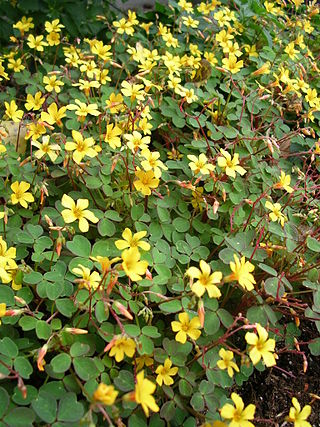
Oxalis spiralis, the spiral sorrel, is a species of plant of the genus Oxalis, a member of the wood sorrel family Oxalidaceae.

Oxalis triangularis, commonly called false shamrock, is a species of perennial plant in the family Oxalidaceae. It is native to several countries in southern South America. This woodsorrel is typically grown as a houseplant but can be grown outside in USDA climate zones 8a–11, preferably in light shade.

Oxalis hedysaroides, known as the fire fern, is not a fern but a flowering perennial plant native throughout Colombia and Ecuador. It is a member of the woodsorrel genus (Oxalis) that grows to 30 cm height and 10 cm spread.
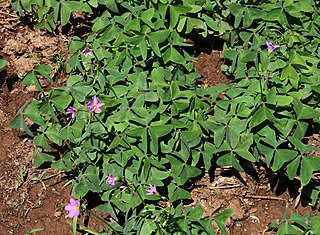
Oxalis latifolia is a species of flowering plant in the woodsorrel family known by the common names garden pink-sorrel and broadleaf woodsorrel. It is native to Mexico and parts of Central and South America.

Swartland Shale Renosterveld is a critically endangered vegetation type of the Western Cape, South Africa.

Limnocharis flava is a species of aquatic flowering plant which is native to Mexico, Central America, South America, Cuba, Haiti and the Dominican Republic but widely naturalized in southern and southeastern Asia: India, Sri Lanka, Cambodia, Burma, Thailand, Vietnam, Indonesia, Malaysia, Brunei and southern China.

Vachellia flava, synonym Acacia ehrenbergiana, is a species of drought-resistant bush or small tree, commonly known as salam in Arabic. It is found in the Sahara, the northern Sahel, parts of East Africa, the Arabian Peninsula and Iran.
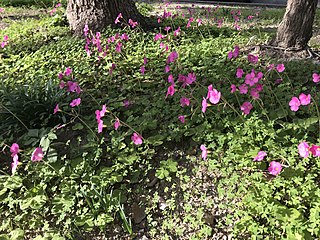
Oxalis articulata, known as pink-sorrel, pink wood sorrel, windowbox wood-sorrel, Chari amilo (Nepal),sourgrass,Netho (khatta) saag (India) is a perennial plant species in the genus Oxalis native to temperate South America. It has been introduced in Europe in gardens and is now naturalized in these areas.
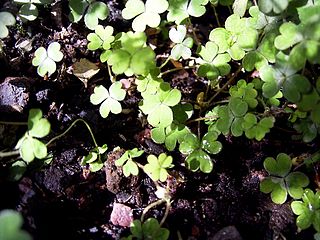
Oxalis magellanica or snowdrop wood-sorrel is an Oxalis species found in Chile, Argentina, New Zealand, and Tasmania. It was first described in 1789. It blooms from fall to spring with white flowers.

Oxalis dillenii, the southern wood-sorrel, slender yellow woodsorrel, or Dillen's oxalis, is a species in the woodsorrel family. Like other Oxalis species, the leaves of this plant resemble clover leaves, with three leaflets. The flowers have five yellow petals that are 4 to 10 mm in length. The leaflets are 1 to 2 cm wide with pointed hairs. The fruits are rather brown and are 1.5 to 2.5 cm. It is often considered a weed, and can be found worldwide, but likely originated in North America.
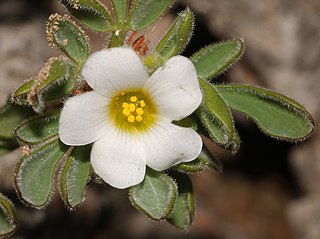
Oxalis virginea, commonly known as Virgin sorrel, is a species from the genus Oxalis. It is endemic to South Africa. O. virginea was first described by Nikolaus Joseph von Jacquin in 1798. This species is apparently lacking a type specimen.
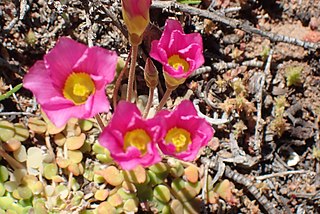
Oxalis inaequalis is a bulb-forming species of flowering plant in the wood sorrel family. It is native to South Africa's Cape Provinces. Each plant produces a rosette of up to 70 succulent leaves, which occasionally produce aerial bulbs. The flowers are yellow and copper-coloured. The sepals are of unequal sizes, hence the specific epithet "inaequalis", which is Latin for "unequal".




















